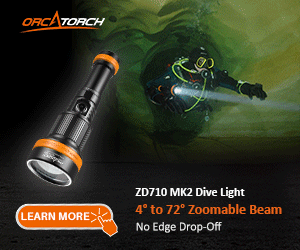You're welcome....
Since you mention hot-shoes.... I should also add that there are two types of TTL -- they both do the same thing, the difference is in the way they are connected.
1. Wired TTL requires a hot shoe on the camera (that presumably supports TTL), an electronic connection in the housing known as a "bulkhead connection, a strobe compatible with the particular flavor of TTL on the camera (they vary by maker) OR a TTL adapter (a little electronics box) that can translate between the camera and strobe, and a proper cable which has wires inside and therefore needs to be sealed with o-rings on all ends. This is the "traditional" way of doing this and is still very common. You need to insure that all the pieces mentioned above exist for your camera and strobe you plan on getting.
2. Optical TTL or "slave" TTL -- this is much simpler and works just as well.... A fiber-optic cable connects between your housing and the strobe. No hot shoe or any other electrical connection is needed. The external strobe is fired by the internal built-in flash in your camera much like a slave, but smarter. Assuming your camera supports TTL with this internal flash (on land, even) and the strobe you get also supports this mode of TTL, what happens is that the external strobe will mimic the duration of fire from the internal strobe and you will get a good exposure. This is a newer method and is gaining popularity even with dSLRs and pros because the connection method is much simpler, does not involve electricity between the camera and strobe, and the fiber-optic cables do not need to be sealed on both ends thereby eliminating several possible flood points. This is what I use with my E-PL2 and twin Sea & Sea YS-110a strobes and within the limits of TTL in general (see what I wrote above), I get very good exposures pretty much all the time.
Bottom line, you need to know what your camera supports and if its #2, I would go with that for simplicity's sake.... #2 can also be quite less expensive if you can't find a strobe directly compatible with your camera and you need to get one of those TTL adapters I mentioned in #1. The YS-110a supports both connection methods. The less expensive and a tiny bit less powerful YS-01 supports only fiber-optic TTL. Both are excellent choices. Inon also makes excellent strobes. The 2000 is optical-only and quite good.
Since you mention hot-shoes.... I should also add that there are two types of TTL -- they both do the same thing, the difference is in the way they are connected.
1. Wired TTL requires a hot shoe on the camera (that presumably supports TTL), an electronic connection in the housing known as a "bulkhead connection, a strobe compatible with the particular flavor of TTL on the camera (they vary by maker) OR a TTL adapter (a little electronics box) that can translate between the camera and strobe, and a proper cable which has wires inside and therefore needs to be sealed with o-rings on all ends. This is the "traditional" way of doing this and is still very common. You need to insure that all the pieces mentioned above exist for your camera and strobe you plan on getting.
2. Optical TTL or "slave" TTL -- this is much simpler and works just as well.... A fiber-optic cable connects between your housing and the strobe. No hot shoe or any other electrical connection is needed. The external strobe is fired by the internal built-in flash in your camera much like a slave, but smarter. Assuming your camera supports TTL with this internal flash (on land, even) and the strobe you get also supports this mode of TTL, what happens is that the external strobe will mimic the duration of fire from the internal strobe and you will get a good exposure. This is a newer method and is gaining popularity even with dSLRs and pros because the connection method is much simpler, does not involve electricity between the camera and strobe, and the fiber-optic cables do not need to be sealed on both ends thereby eliminating several possible flood points. This is what I use with my E-PL2 and twin Sea & Sea YS-110a strobes and within the limits of TTL in general (see what I wrote above), I get very good exposures pretty much all the time.
Bottom line, you need to know what your camera supports and if its #2, I would go with that for simplicity's sake.... #2 can also be quite less expensive if you can't find a strobe directly compatible with your camera and you need to get one of those TTL adapters I mentioned in #1. The YS-110a supports both connection methods. The less expensive and a tiny bit less powerful YS-01 supports only fiber-optic TTL. Both are excellent choices. Inon also makes excellent strobes. The 2000 is optical-only and quite good.



